- Hello, what’s this? The newest Google aerial shows hundreds of chairs and the big Commencement stage set up on the Green. It looks as if the photo was taken just before the Convocation on September 20. It is definitely recent: the Wilson Hall elm is missing, the Crouching Spider is visible, the new scoreboard is casting a shadow on the south end of Memorial Field, the Williamson is under way, Alpha Phi is in place, and the clearing has started for Kappa Delta at the end of Webster Avenue.
- The Planner’s Blog has a couple of photos of the start of the Triangle House renovation. The Trumbull-Nelson magazine has an article on the construction of Alpha Phi and a photo of the Kappa Delta foundation going in.
- Remember the big six-level parking garage in Dewey Field?
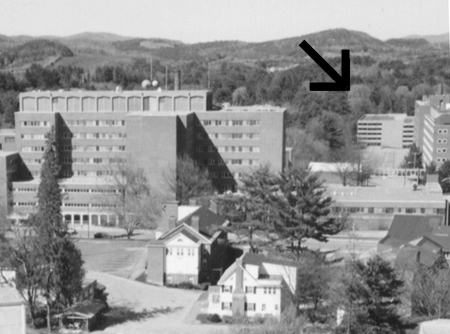
Built in 1972 to hold 490 cars, the garage is visible in this 1995 photo behind Remsen/Vail. The college demolished it in 1996. A Bing aerial shows the current state of the site at the northwest corner of the Dewey Field parking lot, and a Google Street View shows the site from the ground (pan around to see the Google engineers giving the camera trike a sendoff). - It turns out that ADD, Inc., the firm that designed the interior renovations of Home 36 and Home 50, did more than create a new headquarters there for Dana Library. It also created offices there for DCHCDS; and it designed interiors at 4 Currier Place.
- Some notes on education: A small article in Education Life in the Times covers an interesting project, the Minerva Schools. In this attempt to be a non-discount university at a discount price, the idea of renting space in a series of world cities is a neat one. (Also in the supplement is a wordy ad for MALS at Dartmouth (pdf) that seems undesigned — showing directness and honesty, one supposes.) A visit to a Virginia horse fair last weekend turned up booths representing the University of Findlay in Ohio and Centenary College in New Jersey. Interesting. Most of the other booths promoted saddles, animal feed, or pasture fencing.
Category Archives: Med. School
An aerial view of the Academic Center’s site
Bill Hemmel has a nice collection of recent aerial photos of the campus, including this one:

Dartmouth will demolish Gilman (at right, with white window frames) and Dana (the square building above it) to provide a site for the North Campus Academic Center.
At this stage in the design process, the siting of the Academic Center is the best and most interesting attribute of the building. Disobeying the grid that orients the rest of the medical school complex, the Academic Center will approximate the curve of College Street. Here is a very rough guess at the building’s footprint:
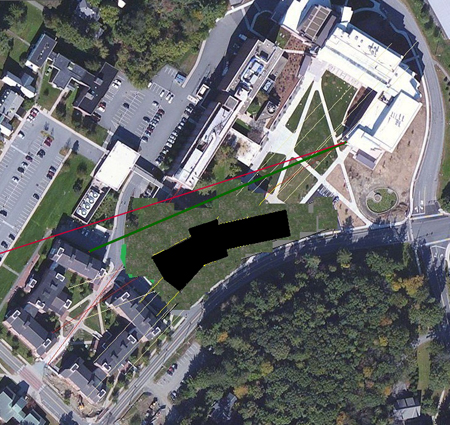
This would seem to rule out a New Maynard Street (not a serious idea):
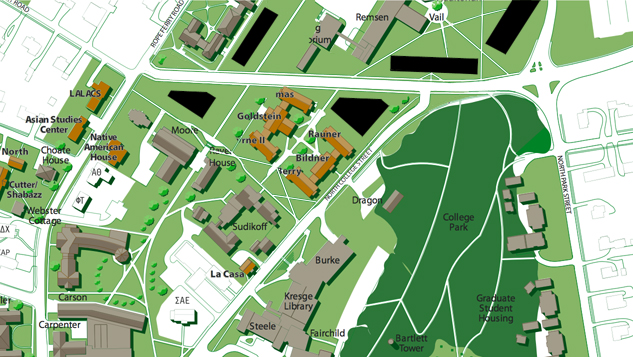
The new building will wall off the medical quad from the street at least as much as Dana does now, and it will finally liberate the quad’s southwestern corner. In place of the frustrating and obstructive hyphen that new joins Gilman to Remsen, the new building will erect a broad ramp to give pedestrians free access to the quad and the Life Sciences Center beyond.
In the context of Vail and its older neighbors, the potentially dull, planar surfaces and ominous cantilevering of the new building might be hard to criticize. This is Dana’s entrance, for example:
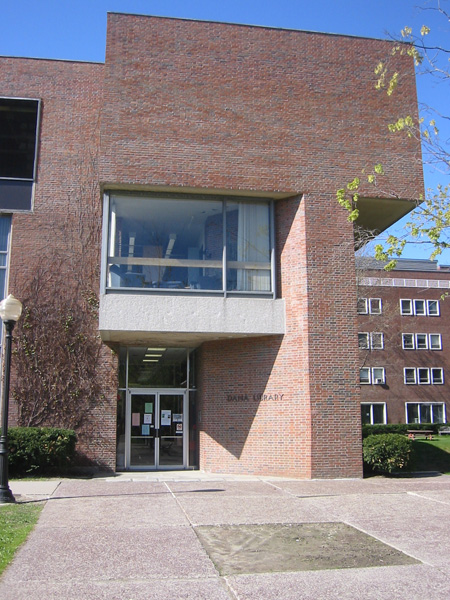
But the obvious difference is that the med school’s Modernist buildings, all by SBRA, are built of red brick. While their scale and style set them apart, their material ties them to the campus. The Academic Center, which initially was shown as having one portion clad in brick, appears to be destined to wear a museumlike white material, possibly stone or metal paneling, all the way around.
The building guidelines in the 2002 Campus Master Plan propose that new buildings maintain at least some connection to the old:
There is a predominance of red brick buildings in Flemish bond, vertical, white, multi-paned windows, entry pediments, and pitched copper roofs. While we do not believe it desirable to limit the design of new buildings to a particular style, the use of some of these existing elements can go a long way in linking the new with the old.
Since it seems to be important to use color to set the Academic Center apart, one wonders whether the building could be built of white-painted brick. The oldest buildings of the campus, those of Dartmouth Row, have been painted white for decades, and yet they have been so little imitated that they remain strikingly different.
—–
[Update 11.17.2012: Broken link to Dana image fixed.]
Heraldry: The Tuck School and the Temple at Hephaestos
I. The Geisel School. The big topic in Dartmouth heraldry is the Geisel School of Medicine’s new shield, mentioned here. It contains the familiar elements of the river, pine, founding date, and book, and it omits the depiction of the old Medical Building, which was demolished about 55 years ago. It deserves an analysis of its own.
II. The Graduate Studies Program. The Grad Studies shield seems to be receiving a big push, with a banner for Dartmouth Night (Grad Studies’ Flickr photostream) and the distribution of decals to students (Flickr).
The shield carries on what seem to be the unifying elements in Dartmouth’s armorial family: (1) the use of a founding date and (2) the placement of wavy lines in the base of the shield to represent the Connecticut River.
Here is how it looks in the group (published in March, shortly before the medical shield was replaced):

The vertical year on the Grad Studies shield does not seem entirely successful in this rendition.
III. The Tuck School.
Graphically, the chunkiness of the Tuck shield, at the far right above, is appealing. It uses an extreme closeup view to cut off the building’s eaves, and its heavy line causes the shield border itself to read as part of the temple front. The Eighteenth-century letterforms are also nice and relate to Dartmouth’s seal, although they are not of the same 1990s (?) language as the rest of the Tuck shield.
The one thing that has always been disturbing about the Tuck shield is that it depicts a nonexistent building. It is not a stylized version of Tuck Hall’s portico; instead it represents a hexastyle Doric temple, like the temple at Hephaestos.
Compare the row of six squat columns without capitals in Hephaestos to the Ionic portico of four relatively attenuated columns in Tuck Hall:
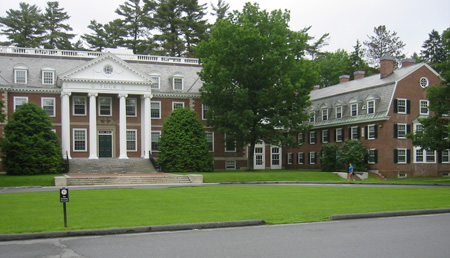


Perhaps this should not be irksome, since Dartmouth’s own shield depicts a nonexistent building as well. One way to resolve the problem would be for the Tuck School to build a hexastyle temple front somewhere on its campus.
—————
[Update 08.16.2012: Green temple-only illustrations added.]
More details on the Academic Center, Dana’s move
The previous post on this topic mentioned that the current rendering (source) of the quad facade differs slightly from an earlier rendering published during May. Some of the changes:
- The eastern (most distant) of the three masses has gone from light-colored stone cladding to something more uniform, possibly metal, and has gained a glazed projection or Window of Appearance. The mass also appears to have taken on a stepped form where it meets the rest of the building.
- The central mass is still a glass box, but the detailing has changed. The third level seems to have been omitted or made into a mezzanine.
- The nearer, western mass has changed from red brick to stone or concrete. The walls of the ground level are largely blank, suggesting that this part of the building will house Dana Library.
Where will Dana go between the demolition of its current building in 2013 and the completion of the new one in 2016? It will occupy Homes 37 and 50, former Nursing School buildings that are now known, as a result of two of the school’s better E-911 naming decisions, as 37 and 50 Dewey Field Road.
The Biomedical Libraries Blog has a plan of the library in its temporary home, with the layout designed by ADD Inc.
—–
[Update 03.31.2013: Broken link to library plan replaced.]
[Update 11.17.2012: Broken link to library blog fixed.]
[Update 08.19.2012: It looks as if the addresses of the buildings at 37 and 50 Dewey Field Road have been consolidated, and the building built in 1950 (i.e. Home 50) is now numbered 37 Dewey Field Road.]
The Academic Center is by Kyu Sung Woo Architects
The designers behind the planned North Campus Academic Center are the Cambridge, Mass. firm of KSWA. Firm founder Kyu Sung Woo (Wikipedia) designed the Olympic Village for the 1988 Olympics in Seoul (firm page).
The firm’s campus work includes a pair of dorms on Coffin Street at Bowdoin (firm page) and the Nerman Museum in Kansas (Architectural Record, Biemiller post at the Buildings & Grounds blog of The Chronicle).
The project page for the North Campus Academic Center at Dartmouth provides a slightly modified version of the May view of the building’s rear or quad facade as well as a view to the southwest showing the “front” facade on College Street.
What’s most notable is the siting: this building has some major planning implications. The building is not an east-west bar as its predecessor Gilman was. Instead, it appears to follow a northeast-southwest orientation, forming an angled tee shape (a favored form — see the Nerman plan). The dominant main block will follow the angle of College Street as it heads off toward Lyme. The southern end of the building, the stem of the tee, appears to adopt the orientation of the McLaughlin Cluster.
Thus, instead of forming a rectilinear wall along the bottom of the medical quad as Gilman did, the building opens like a trap door, allowing the quad to spill out to the McLaughlin Cluster.
Some new details about the building’s contents and surroundings:
Classrooms, meeting rooms, a graduate student lounge and social space, a cafe, and a large scale forum will be available to the Dartmouth community. The building will be set in a landscape featuring outdoor performances, art events, and a gathering space for major events such as the Medical School commencement.
The Life Sciences Center also was described as framing a space for commencements. Thus the commencement space mentioned above seems likely to be the existing medical quad rather than the sunken lawn visible in the first illustration.
———-
[Update 08.11.2012: KSWA’s authorship of the Academic Center was mentioned as early as March 9 on a Korea.net article titled “Design by Korean architect dazzles in Boston.”]
An Academic Center update
A memorandum published in connection with the Academic Center/Williams bond (pdf) states on A-9 and A-10 that the North Campus Academic Center will replace Gilman and Dana, is scheduled to begin during July of 2013, and is expected to be substantially complete by March of 2016.
The building is planned to house the Departments of Sociology and Anthropology (the college was mum about this in an article in The Dartmouth, and the plan might still be in flux); the Center for Healthcare Delivery Science; the Institute for Health Policy and Clinical Practice; Dana Biomedical Library; and the administration of the Geisel School.
Elsewhere, it is noted that the Academic Center is a registered LEED project.
And what about the bridge to Kellogg — will it survive? It could be hidden behind the screen visible on the left side of the image published here recently.
Will Dartmouth demolish Gilman and Dana?
At Commencement the Board announced the construction of the Williamson Translational Research Building at the hospital (a project announced in 2007) and, more notably here, of a “North Campus Academic Center” (Dartmouth Now via Jon).
The Academic Center will contain classrooms, academic offices for DCHCDS and other programs, and the Dana Biomedical Library, an institution that currently occupies its own building. The Center might be made up of multiple buildings: “Dartmouth director of project management Matt Purcell says that the school … is developing two buildings for its new North Campus Academic Center” (Real Estate Bisnow Boston).
An overlooked document from a conference last month (pdf) includes a rendering of the buildings:
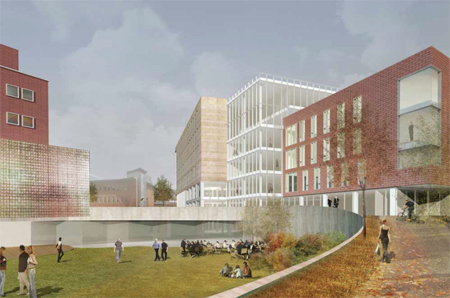
That brick building behind the new screen on the left is Remsen. Compare this view:
The buildings shown in the rendering occupy the sites of Gilman and Dana. Those buildings are not particularly popular, and their demolition would have been good to mention in the press release.
Acknowledging that the rendering probably does not represent a final design, what can be said about the project? It looks better than Gilman. The far block, with its stone (?) cladding, might be the library replacement. The less pretentious near block, of brick-red cast masonry units (?), is probably the classroom building. Between the two is a glazed tower. The sweeping concrete wall and bridge is a bit too Fairchild, but it should improve the circulation in the area and make the Medical School more porous and campuslike.
The rendering above was an interesting one to choose as the representative of this project: it is not the view from the street or from the center of campus. Instead, it looks to the northwest from around the center of the left edge of this aerial:
If Gilman is to go, the school should save the wonderful (Scotford-designed?) lettering from its entrance and the polite sculpture that is affixed to the east end of the building.
Townscape: The view from Sudikoff.
Even though Gilman long predates the McLaughlin Cluster, it provides a not-bad terminus for the Cluster’s main vista. The new academic centers building now has an opportunity to provide an intentional northern end to the axis. Without being heavy-handed or obvious, this building also could provide a gateway to the medical school — perhaps not Seussian gargoyles (a fertile field…) but some acknowledgment, such as a pedestrian passage or an inscribed granite lintel, that this is where one institution ends and another begins.
—————-
[Update 07.07.2012: Townscape information and better comparison image added. The gold lettering visible in a photo from The Dartmouth is the salvage-worthy Gilman detail referred to above. It seems from the photo to be painted on the transom. If that panel is removed and is not installed in the replacement building, what happens to it? What happens to all the notable elements that surely are removed from demolished buildings? Until there is a Dartmouth Museum, they could be displayed in the studios at 4 Currier or the VAC. (Dartmouth could indeed build a museum to its own past and stock it with the realia now in the archives.)]
The 122,000-square foot North Campus Academic Center is scheduled to contain:
- 18 classrooms
- the Dana Biomedical Library
- interdisciplinary space for the Geisel School of Medicine; the Dartmouth Institute for Health Policy and Clinical Practice; the Dartmouth Center for Health Care Delivery Science; and the Department of Sociology
Sources: Dartmouth Now and Tradeline.]
[Update 08.12.2012: There is other lettering at the east end of Gilman as well.]
The Heater Road building, a renovation at the hospital, and a new building for the Geisel School
The Valley News reports on growth at the ever-expanding DHMC.
(There is also a great low-angle aerial view of DHMC on Dartmouth’s Flickr stream.)
The Heater Road building (a prior post) is nearing completion. About 200 people will move there from the main DHMC complex.
Then DHMC can perform a $16.6m renovation on one of its existing buildings to add critical-care beds. (And “DHMC’s mail services are being moved off the Lebanon campus and into a former U.S. Postal Service building in Centerra Park.”)
Finally, during their March meeting the trustees voted to approve a capital budget that includes “design funding for the Williamson Translational Research Building on the medical school’s Lebanon, N.H. campus” (The Dartmouth). The press release states:
The building will house programs concerned with adapting laboratory discoveries to use in patient care, with an emphasis on multi-disciplinary problem solving in areas including neuroscience, cardiovascular science, and immunology/infectious diseases, among others.
————
[Update 08.12.2012: Construction on Williamson will begin during June of 2013 and finish by September of 2015. The existing $20 million pledge will cover part of the estimated cost of $115 million. Bond info pdf, A-10.]
—–
[Update 11.17.2012: Broken link to bond report fixed.]
Renaming the Medical School
Dartmouth has changed the name of its medical school1Inspired by a recent article in Businessweek on the cost of naming rights for business schools, this morning I jotted down the idea for a post on Dartmouth’s offer of naming rights for its medical school, an offer previously noted here in 2005. It was not ten minutes later that I received the announcement, presumably held for release until after April Fool’s Day, that Dartmouth had named its medical school after Dr. Seuss. from the Dartmouth Medical School to the Audrey and Theodor Geisel School of Medicine at Dartmouth. Dr. Seuss, as Dartmouth’s most famous “doctor” [of philosophy], would seem to be as good a namesake as any.
Now the medical school fits the pattern established by Dartmouth’s two later professional schools. The current names of the three institutions seem to be:
- The Tuck School (the Tuck School of Business at Dartmouth College)
- Thayer School (the Thayer School of Engineering)
- The Geisel School (the Geisel School of Medicine at Dartmouth).
The Medical School has a long tradition of changing its name, and it sometimes goes by several names at once. An 1897 note titled “Name of the School” reads:
The name of the Medical Department seems to have changed several times. In 1806 the broadside list of students is headed: “Catalogue of the Medical Students and Students of College who attended the Medical Lectures at Dartmouth University” (as far back as Sept. 20, 1782, the Trustees passed a resolution styling the College a University); that of 1811, “Catalogue of the Dartmouth Medical Theatre;” that of 1814, “Catalogue of the Medical Institution at Dartmouth University;” that of 1817, “Catalogue of the Dartmouth Medical Institution.” At some time between this date and 1824 the name “New Hampshire Medical Institution” began to be used and was retained until 1880 though the official title has always been the “Medical Department of Dartmouth College.”2Phineas S. Conner, Historical Address, in “Dartmouth Medical College Centennial Exercises” (1897), 27.
The name “the Medical Department,” which is not explained by the note, was in use at least by 1812.3Dartmouth Trustees meeting minutes (1812), quoted in Conner, 57. Other examples include “the Medical College” (1871,4Medical faculty meeting minutes (1871), quoted in Conner, 61. 1880,5Oliver P. Hubbard, The Early History of the New Hampshire Medical Institution (Washington, D.C.: Oliver P. Hubbard, 1880), 37. 18836Medical faculty meeting minutes (1883), quoted in Conner, 61.), “the Dartmouth Medical College” (1868,7Medical faculty meeting minutes (1868), quoted in Conner, 56. 1895,8Dartmouth medical faculty meeting minutes (1895), quoted in Conner, 46. 18979Conner, 22.), “the Medical School of New Hampshire” (189310Petition of New Hampshire Medical Society (1893), quoted in Conner, 33.), “the Medical Institution at Hanover” (189311Petition (1893), quoted in Conner, 33.), “the Medical School” (180912New Hampshire Legislature (1809), quoted in Conner, 29. Note that the school’s 1811 building, depicted on the old shield above, was itself initially called “the Medical School.”), and of course “the Dartmouth Medical School” (1880,13”From Abroad,” Medical Times and Gazette (11 December 1880), 660. 1897,14Conner, 17, 23.).
This would seem to be a good time to change the 1950s (?) shield again,15Jonathan Good has pointed out that the shield’s original Indian-head cane, shown above, was replaced by a conventional staff of Aesculapius during or before 2010. and it looks as if the school has already thought of that.
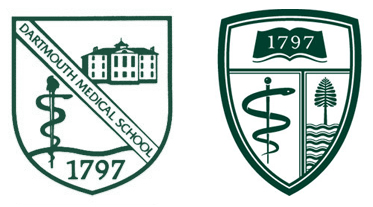
———————-
[Update 04.05.2012: Caduceus corrected to Aesculapius.]
[Update 04.19.2012: Suppositional name “The Geisel School of Medicine” shortened to “The Geisel School.”]
———————-
| ↑1 | Inspired by a recent article in Businessweek on the cost of naming rights for business schools, this morning I jotted down the idea for a post on Dartmouth’s offer of naming rights for its medical school, an offer previously noted here in 2005. It was not ten minutes later that I received the announcement, presumably held for release until after April Fool’s Day, that Dartmouth had named its medical school after Dr. Seuss. |
|---|---|
| ↑2 | Phineas S. Conner, Historical Address, in “Dartmouth Medical College Centennial Exercises” (1897), 27. |
| ↑3 | Dartmouth Trustees meeting minutes (1812), quoted in Conner, 57. |
| ↑4 | Medical faculty meeting minutes (1871), quoted in Conner, 61. |
| ↑5 | Oliver P. Hubbard, The Early History of the New Hampshire Medical Institution (Washington, D.C.: Oliver P. Hubbard, 1880), 37. |
| ↑6 | Medical faculty meeting minutes (1883), quoted in Conner, 61. |
| ↑7 | Medical faculty meeting minutes (1868), quoted in Conner, 56. |
| ↑8 | Dartmouth medical faculty meeting minutes (1895), quoted in Conner, 46. |
| ↑9 | Conner, 22. |
| ↑10 | Petition of New Hampshire Medical Society (1893), quoted in Conner, 33. |
| ↑11 | Petition (1893), quoted in Conner, 33. |
| ↑12 | New Hampshire Legislature (1809), quoted in Conner, 29. Note that the school’s 1811 building, depicted on the old shield above, was itself initially called “the Medical School.” |
| ↑13 | ”From Abroad,” Medical Times and Gazette (11 December 1880), 660. |
| ↑14 | Conner, 17, 23. |
| ↑15 | Jonathan Good has pointed out that the shield’s original Indian-head cane, shown above, was replaced by a conventional staff of Aesculapius during or before 2010. |
Street addresses on campus
Yale has been described as having more buildings with street addresses than any other school.1I thought this factoid was in Scully, et al., Yale in New Haven: Architecture and Urbanism (Yale, 2004), but I cannot find it there. See Cooper, Robertson & Partners, Yale University: A Framework for Campus Planning (pdf), 9 (“City streets connect the blocks, giving most buildings at Yale clear street addresses.”); id, 36 (“Nearly every University building has a city street address.”). That might have been the case 15 years ago, but in the age of E911 address requirements, there should not be a campus building anywhere in the country without a street number.
This is interesting: Dartmouth’s Class of 1978 Life Sciences Center, which basically is part of the old Med School campus along College Street, had its street number changed from 76 College Street to 78 College Street.2Dartmouth Alumni Magazine (January/February 2012) (pdf), 14.
——-
[Update 11.04.2012: First sentence changed, citation to Yale plan added, and DAM citation placed in footnote.]
——
| ↑1 | I thought this factoid was in Scully, et al., Yale in New Haven: Architecture and Urbanism (Yale, 2004), but I cannot find it there. See Cooper, Robertson & Partners, Yale University: A Framework for Campus Planning (pdf), 9 (“City streets connect the blocks, giving most buildings at Yale clear street addresses.”); id, 36 (“Nearly every University building has a city street address.”). |
|---|---|
| ↑2 | Dartmouth Alumni Magazine (January/February 2012) (pdf), 14. |
Brand identity topics
I. The Dartmouth Company
Curiously, there is a Boston-based real estate company called The Dartmouth Company. It makes good use of serifs and a dark green color on its website and seems to operate in New Hampshire. See also the more obvious reference to the college at the Dartmouth Education Foundation.
II. The Arms of Dartmouth’s Schools
The Dartmouth College website seems to be doing something new when it describes the institution as a collection of five apparently equal schools:
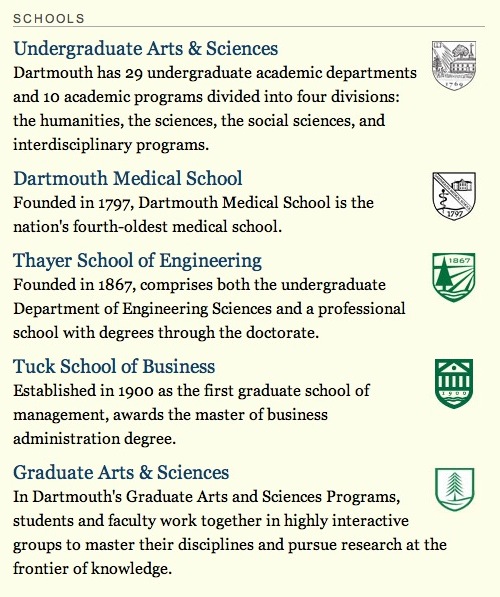
The harmonization and use of the schools’ shields is commendable.
But this arrangement seems to contradict the rule that Dartmouth is the college. The “Associated Schools” — Tuck, Thayer, Medical, and lately the graduate programs — are associated with the college but are not coequals beneath a central university administration. Because “Dartmouth” is the undergraduate college, there is no need to put the letters “CA&S” before one’s class year, for example.
Tom Owen writes in The Dartmouth today:
In the discussion following Kim’s address, Provost Carol Folt said there is a “complicated set of reasons” for the gap between Dartmouth’s national and international rankings. Two of the major contributing factors are Dartmouth’s lack of a “university” title and Dartmouth’s focus on undergraduates, both of which have hurt Dartmouth’s international reputation.
[…]
Although large-scale changes may be necessary in the next decade, alumni must see new developments as part of an institutional history of adaptation rather than as a threat to tradition, Kim said.
The school’s Quartomillennium celebration in 2019 would be a good time to launch something new.
[01.25.2012 update: Education Foundation link added.]
Architectural and other notes
- The Real Estate Office’s new office building at 4 Currier, designed by Truex Cullins, was awarded a LEED Silver rating.
- College Photographer Joseph Mehling ’69 is retiring (The Dartmouth). Among hundreds of college-related projects, Mehling provided the photos for the Campus Guide.
- The Rauner Library Blog notes that the Freshman Book — the Shmenu — was last printed on paper in 2009.
- CRREL, the Army’s Cold Regions Research and Engineering Laboratory north of campus, was giving tours recently (Valley News).
- Old fire insurance maps of American cities and towns produced by the Sanborn Map Company are invaluable to historians. A post at Bibliodyssey features the elaborate designs displayed on the title pages of Sanborn maps.
- According to hikers interviewed for an article in The Dartmouth, all of Hanover’s mile markers for the Appalachian Trail are inaccurate. Experience with the Milepost on a couple of drives up the Alcan suggests that the inaccuracies result from the practice of rerouting the trail.
- The watering trough that once occupied the southwest corner of the Green is featured in a post at the Review.
- The ongoing basketball office renovations in the Berry Sports Center are planned to include a “display of Dartmouth basketball history and tradition” (Valley News).
- The Dartmouth had an article back in May about how Rauner librarians hope that the players of new metadata games will help them attach information to untagged photos.
- Randall T. Mudge & Associates Architect has exterior and interior photos of the Dragon Senior Society hall. The interior paneling, taken from Dragon’s 1931 hall behind Baker, really does look like a Larson & Wells product.
- The site What Was There brings rephotography into the digital era by superimposing historic photos on Google Street View images.
- Yale’s new residential colleges site has a nice site map (pdf) showing existing colleges and site of the two new colleges designed by architecture school dean Robert A.M. Stern. The Grove Street Cemetery really is in the way…
- An article explains the move from the old hospital north of Maynard Street to the new DHMC complex in Lebanon 10 years ago.
—–
[Update 05.03.2014: Broken link to trough article replaced.]
[Update 05.12.2013: Broken link to Dragon photos removed.]
[Update 01.13.2013: Broken link to new residential colleges replaced, broken link to site map removed.]
Dartmouth Traditions by William Carroll Hill (1901)
Download
Download a pdf version of William Carroll Hill’s 1901 book, Dartmouth Traditions.
About the Book
William Carroll Hill (1875-1943?), of Nashua, N.H., received his Bachelor of Letters degree, a degree offered only between 1884 and 1904, in 1902. He was the historian of his class and wrote the Chronicles section of the the 1902 Class Day volume, a book that the printer gave the appearance as Dartmouth Traditions. Hill became an antiquarian, genealogist, and historian and apparently wrote a history of the New England Historic Genealogical Society.
Dartmouth Traditions was published when Hill was a junior. The book is not really about traditions and probably would be better titled Dartmouth Worthies. It is a collection of essays written by students and alumni. While the essays on Daniel Webster and other known personages are not very useful, some essays appear the contain information that is only available in this book. Examples are the report on the investigation into the history of the Lone Pine and the first-person account of the drowning death of Harriet Beecher Stowe’s son.
About this Project
The transcription of this somewhat hard-to-find book began in 2003. The book has since become available in Google Books, which somewhat defeats the purpose of the project. The Google Books version has the great advantage of reproducing the attractive typography of the original, but its computer transcription is not as accurate as that of the version presented here.
[Update 05.13.2011: The Rauner Library Blog has a post on Hill, highlighting the Stowe episode.]
[Update 12.21.2010: Link to pdf posted.]

Economy slows hospital expansion too
The Valley News reports that the outpatient surgery center (2008-2010) is going ahead but confirms that the Koop Medical Science Complex is on hold.
The November 13 letter from Barry Scherr and Adam Keller (pdf) stated: “We will complete planning already under way for projects which would then require additional financial resources before proceeding to the next phase: Class of 1953 Commons and the C. Everett Koop Medical Science Complex.” The three-part complex planned for the south end of the hospital is shown in a November 3, 2006 announcement and is explained in detail on its capital campaign page.
—–
[Update 01.05.2013: Broken link to campaign page removed.]
Strasenburgh’s past
The Class of 1978 Life Sciences Building is taking the place of Strasenburgh Hall, a cramped Medical School office building. Strasenburgh was built as a dormitory, and for that reason it was the only building on the School’s “original” (1950-1980) campus not designed by SBRA: the dormitory, like its Tuck School counterpart Buchanan Hall, was designed by the consulting architects of the College, Campbell Aldrich & Nulty.
Dartmouth Medicine magazine (Winter 2006) has an article by Jennifer Durgin on Strasenburgh’s past, and it includes an excellent aerial photo of the medical campus. Strasenburgh’s small scale and busy faceting made it one of the least unappealing buildings of the group.
Medical School expands its Lebanon campus
One of the new building groups out at the hospital is the Koop Center (SBRA, 2008-2010). See the floorplan (pdf). A view of the interior of the volume joining the center’s two wings, called LeBaron Commons, is available as well (pdf). One of the wings has a name that seems to be fairly new: the Williamson Translational Research Building.
For reference, this big addition seems to be at the bottom of the current hospital map (pdf).
A perspective drawing of the complex suggests the direction of the Medical School’s “Future Campus” (pdf).
—–
[Update 11.17.2012: Broken links to three pdfs hosted at “transmed.dartmouth.edu” removed.]
The steam tunnel continues
Dartmouth’s steam tunnel continues to stretch northward. A thumbnail sketch:
- From Heating Plant along the Green to the Berry site (mid-1990s)
- From Berry site up Berry Row to Moore (around 1998)
- From Moore, tap into historic hospital tunnel network to reach Kellogg Auditorium and adjoining chiller plant (early 2000s?)
- From Kellogg, run northward behind Medical School to future Life Sciences Building site (2007).
Photos of model of Life Sciences Building
More detailed plans and photos of a model of the Life Sciences Building are available. The building has a bit of the New Deal Post Office about it (see the Post Office of Old Chester, Pa.), while the gabled greenhouse gives it some of the feeling of the Mausoleum at Halicarnassus and thus Pope’s Scottish Rite Temple in Washington, D.C.

—–
[Update 11.12.2012: Broken link to image fixed.]